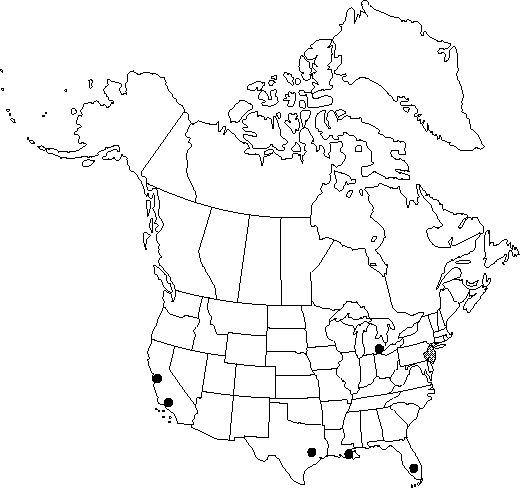Difference between revisions of "Parietaria judaica"
Fl. Palaest., 32. 1756.
FNA>Volume Importer |
FNA>Volume Importer |
||
| Line 20: | Line 20: | ||
}}<!-- | }}<!-- | ||
| − | --><span class="statement" id="st- | + | --><span class="statement" id="st-undefined" data-properties=""><b>Herbs,</b> perennial from crown, 1-8dm. <b>Stems</b> ascending, erect, or decumbent. <b>Leaf</b> blades narrowly to broadly elliptic, lance-elliptic, or ovate, 1.3-9 × 0.8-4.5 cm, base attenuate, cuneate, or broadly rounded, apex abruptly acuminate to long-attenuate. <b>Flowers</b>: involucral bracts 1.5-2.5 mm; tepals ca. 2-3.5 mm, longer than bracts. <b>Achenes</b> dark brown, symmetric, 1-1.2 × 0.6-0.9 mm, apex acute, mucro absent or minute; stipe centered, on cylindric base.</span><!-- |
-->{{Treatment/Body | -->{{Treatment/Body | ||
| Line 26: | Line 26: | ||
|habitat=Cracks in sidewalks, ballast heaps, waste places, frequently about ports and coastal areas | |habitat=Cracks in sidewalks, ballast heaps, waste places, frequently about ports and coastal areas | ||
|elevation=0-200 m | |elevation=0-200 m | ||
| − | |distribution=Calif.;Fla.;La.;Mich.;N.J.;N.Y.;Pa.;Tex.;Eurasia;n Africa | + | |distribution=Calif.;Fla.;La.;Mich.;N.J.;N.Y.;Pa.;Tex.;Eurasia;n Africa. |
|discussion=<p>Parietaria judaica, which, in North America, is most abundant in scattered localities in California, is the only long-lived perennial species of Parietaria in the flora. Because of confusion in Europe over the correct name, plants in North America have been called P. judaica, P. officinalis of authors, not Linnaeus, P. officinalis var. erecta (Mertens & Koch) Weddell, and P. officinalis var. diffusa (Mertens & Koch) Weddell. For a clarification of the nomenclature and taxonomy of this complex, see C.C. Townsend (1968).</p><!-- | |discussion=<p>Parietaria judaica, which, in North America, is most abundant in scattered localities in California, is the only long-lived perennial species of Parietaria in the flora. Because of confusion in Europe over the correct name, plants in North America have been called P. judaica, P. officinalis of authors, not Linnaeus, P. officinalis var. erecta (Mertens & Koch) Weddell, and P. officinalis var. diffusa (Mertens & Koch) Weddell. For a clarification of the nomenclature and taxonomy of this complex, see C.C. Townsend (1968).</p><!-- | ||
--><p>Parietaria judaica was first reported from Louisiana as P. diffusa Mertens & Koch, another name commonly used on herbarium specimens (J.W. Thieret 1969).</p> | --><p>Parietaria judaica was first reported from Louisiana as P. diffusa Mertens & Koch, another name commonly used on herbarium specimens (J.W. Thieret 1969).</p> | ||
| Line 47: | Line 47: | ||
|habitat=Cracks in sidewalks, ballast heaps, waste places, frequently about ports and coastal areas | |habitat=Cracks in sidewalks, ballast heaps, waste places, frequently about ports and coastal areas | ||
|elevation=0-200 m | |elevation=0-200 m | ||
| − | |distribution=Calif.;Fla.;La.;Mich.;N.J.;N.Y.;Pa.;Tex.;Eurasia;n Africa | + | |distribution=Calif.;Fla.;La.;Mich.;N.J.;N.Y.;Pa.;Tex.;Eurasia;n Africa. |
|introduced=true | |introduced=true | ||
|reference=None | |reference=None | ||
| Line 53: | Line 53: | ||
|publication year=1756 | |publication year=1756 | ||
|special status=Introduced | |special status=Introduced | ||
| − | |source xml=https://jpend@bitbucket.org/aafc-mbb/fna- | + | |source xml=https://jpend@bitbucket.org/aafc-mbb/fna-data-curation.git/src/9216fc802291cd3df363fd52122300479582ede7/coarse_grained_fna_xml/V3/V3_448.xml |
|genus=Parietaria | |genus=Parietaria | ||
|species=Parietaria judaica | |species=Parietaria judaica | ||
| − | |||
| − | |||
| − | |||
| − | |||
| − | |||
| − | |||
| − | |||
| − | |||
| − | |||
| − | |||
| − | |||
| − | |||
| − | |||
| − | |||
| − | |||
| − | |||
| − | |||
| − | |||
| − | |||
}}<!-- | }}<!-- | ||
-->[[Category:Treatment]][[Category:Parietaria]] | -->[[Category:Treatment]][[Category:Parietaria]] | ||
Revision as of 14:41, 27 July 2019
Herbs, perennial from crown, 1-8dm. Stems ascending, erect, or decumbent. Leaf blades narrowly to broadly elliptic, lance-elliptic, or ovate, 1.3-9 × 0.8-4.5 cm, base attenuate, cuneate, or broadly rounded, apex abruptly acuminate to long-attenuate. Flowers: involucral bracts 1.5-2.5 mm; tepals ca. 2-3.5 mm, longer than bracts. Achenes dark brown, symmetric, 1-1.2 × 0.6-0.9 mm, apex acute, mucro absent or minute; stipe centered, on cylindric base.
Phenology: Flowering all year, with peak in late winter–spring.
Habitat: Cracks in sidewalks, ballast heaps, waste places, frequently about ports and coastal areas
Elevation: 0-200 m
Distribution

Calif., Fla., La., Mich., N.J., N.Y., Pa., Tex., Eurasia, n Africa.
Discussion
Parietaria judaica, which, in North America, is most abundant in scattered localities in California, is the only long-lived perennial species of Parietaria in the flora. Because of confusion in Europe over the correct name, plants in North America have been called P. judaica, P. officinalis of authors, not Linnaeus, P. officinalis var. erecta (Mertens & Koch) Weddell, and P. officinalis var. diffusa (Mertens & Koch) Weddell. For a clarification of the nomenclature and taxonomy of this complex, see C.C. Townsend (1968).
Parietaria judaica was first reported from Louisiana as P. diffusa Mertens & Koch, another name commonly used on herbarium specimens (J.W. Thieret 1969).
Selected References
None.